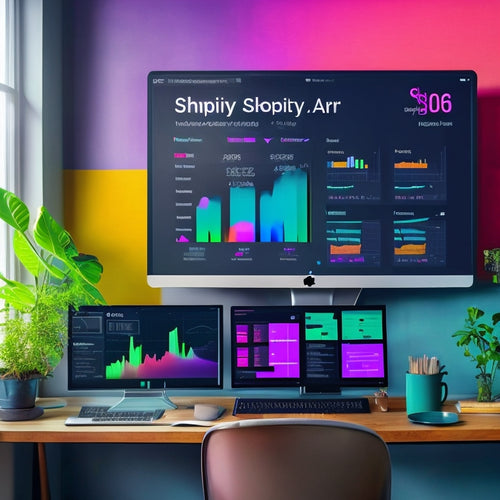
Unlocking Ecommerce Success With A/B Testing
Share
You're missing out on significant conversions and sales by not using A/B testing to optimize your ecommerce store's performance. By testing variations of your website, you can identify winners with statistical significance and make data-driven decisions to achieve your desired goals. Companies like Amazon, Walmart, and Expedia have seen remarkable results, with increases in sales, conversion rates, and customer satisfaction. By streamlining your A/B testing process, you can eliminate guesswork, accelerate experimentation, and focus on conversion optimization. Get ready to reveal the full potential of your ecommerce store and discover the strategies that will drive your success forward.
Key Takeaways
• A/B testing empowers data-driven decisions, driving real growth by identifying winning variations that resonate with the target audience.
• Structured testing eliminates guesswork, automates experimentation, and refines strategies for efficient testing and continuous improvement.
• Optimizing every aspect of the customer journey is crucial, including navigation, search, product pages, and checkout processes.
• Proven success stories demonstrate the impact of A/B testing on eCommerce success, with significant increases in sales, conversions, and customer satisfaction.
• By streamlining A/B testing, eCommerce businesses can accelerate experimentation, improve user experience, and boost conversions, leading to eCommerce success.
A/B Testing Fundamentals
To achieve ecommerce success, you need to understand the basics of A/B testing, a method of comparing two versions of a web page, email, or application to determine which one performs better in relation to achieving your desired goals.
You'll create test variations, such as changes to buttons, images, or content, to see which one resonates with your audience. The goal is to identify the winner with statistical significance, ensuring that the results aren't due to chance.
Data-Driven Decision Making
With A/B testing results in hand, you're empowered to make data-driven decisions that drive real growth, rather than relying on intuition or guesswork.
You've gathered valuable insights into what resonates with your customers and what doesn't. Now, it's time to analyze those results and understand user behavior. Post-test analysis is pivotal in identifying areas of improvement and opportunities for optimization.
By digging deeper into your data, you'll uncover patterns and trends that inform your decisions. This data-driven approach enables you to refine your strategies, enhance the user experience, and ultimately, boost conversions.
Proven Success Stories
You've seen the power of data-driven decision making in action, now it's time to explore the tangible results that A/B testing has delivered for other eCommerce businesses. Let's delve into some real-life case studies that demonstrate the impact of A/B testing on conversion rates and customer insights.
| Case Study | Impact Analysis |
|---|---|
| Amazon | 10% increase in sales by testing product recommendations |
| Walmart | 11% boost in conversion rates by optimizing checkout process |
| Expedia | 21% increase in bookings by streamlining search results |
| Zappos | 12% increase in customer satisfaction by testing product filtering |
| Target | 9% increase in sales by testing product placement on homepage |
These success stories show that A/B testing can drive real results for eCommerce businesses. By applying similar strategies, you can explore similar success for your online store.
Streamlining A/B Testing
By implementing a structured approach to A/B testing, eCommerce businesses can eliminate guesswork, accelerate experimentation, and drive more conversions from their optimization efforts.
You can streamline your testing process by prioritizing hypotheses, automating tests, and leveraging tools like ConvertMate to refine your strategy. This will help you achieve testing efficiency, allowing you to run more experiments in less time.
By focusing on conversion optimization, you'll be able to identify and capitalize on opportunities to improve your website's user experience, leading to increased sales and revenue.
With a streamlined approach, you'll be able to make data-driven decisions faster, driving continuous improvement and eCommerce success.
Optimizing Ecommerce Performance
To maximize your eCommerce store's performance, continuously refining and optimizing every aspect of the customer journey, from landing page to checkout, is crucial. By doing this, you'll increase conversion rates and enhance user engagement.
| Optimization Strategy | Desired Outcome |
|---|---|
| Streamline navigation and search | Decrease bounce rates and boost conversions |
| Enhance product page content | Increase user engagement and decrease cart abandonment |
| Simplify checkout process | Boost conversion rates and minimize friction |
Frequently Asked Questions
How Long Should I Run an A/B Test to Get Reliable Results?
You should run an A/B test until you reach statistical significance, typically 1-4 weeks, to guarantee reliable results, avoiding test overlap and conflicting results that can mislead your data-driven decisions.
Can I Run Multiple A/B Tests on the Same Webpage Simultaneously?
Did you know that 71% of companies use A/B testing to enhance conversion rates? When running multiple A/B tests on the same webpage, make sure each variation has a distinct goal to avoid conflicting results; simultaneous testing can be risky, but with careful planning, it can boost conversion rates considerably.
What Is the Minimum Sample Size Required for a Statistically Significant Test?
To determine the minimum sample size, you'll need to conduct a power analysis, considering factors like significance level, effect size, and confidence interval. This guarantees your test results are statistically significant and reliable.
How Do I Handle A/B Testing During Peak Sales Periods or Holidays?
During peak sales periods, you'll want to prioritize testing, focusing on high-impact experiments that won't disrupt your workload. Monitor conversion rates closely, and be prepared to pause tests if they negatively impact sales, ensuring a safe and successful holiday season.
Can I Use A/B Testing for Mobile App Optimization as Well as Websites?
You can definitely use A/B testing for mobile app optimization, just like websites, to refine user experience and improve conversion rates. By testing different app elements, you'll uncover data-driven insights to optimize your app for better user engagement and retention.
Related Posts
-

Optimize Digital Product Sales With Seamless Integrations
By integrating your digital products with seamless payment gateways, simplified delivery systems, and automated marke...
-
Why Are Shopify Sitemaps Important?
This article examines the significance of Shopify sitemaps and their role in e-commerce websites. It outlines the be...
-

Mastering Shopify: Secrets to Success
This article, titled 'Mastering Shopify: Secrets to Success,' offers valuable insights and strategies for individual...

